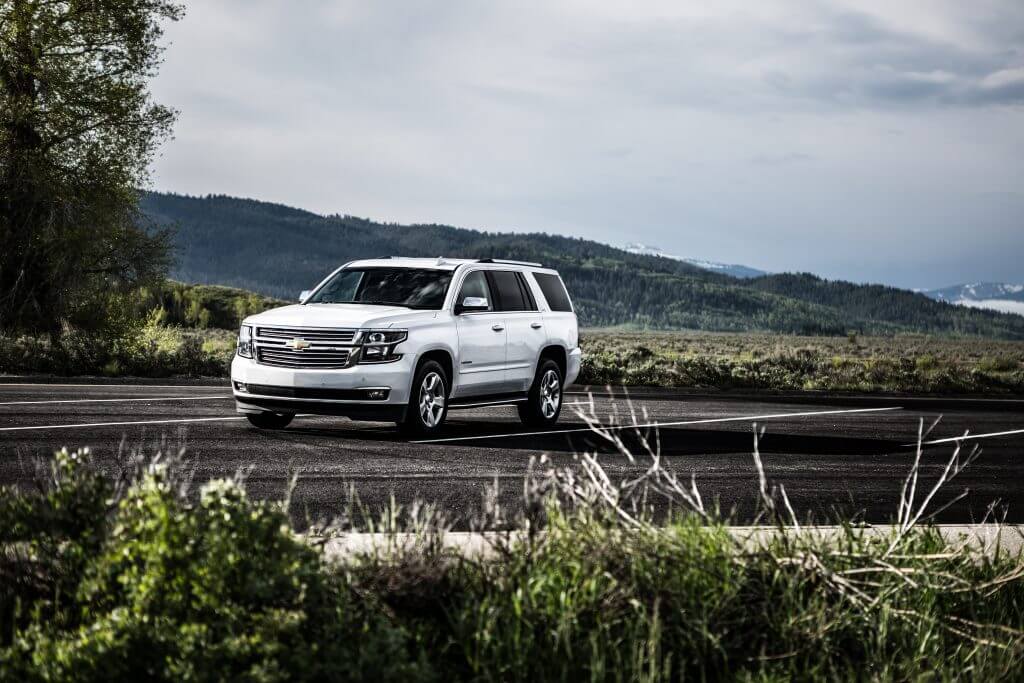The challenge with needing a V8-powered, three-row SUV is that there aren’t too many choices, particularly if you don’t want to drive a premium brand. Besides the Chevrolet Tahoe (and other General Motors products, the Chevy Suburban and GMC Yukon/Yukon XL), there’s a smattering of competing vehicles from Ford, Toyota, Jeep, and Nissan. So, it’s unsurprising that the Tahoe is the perennial U.S. sales leader among non-luxury large SUVs.
That’s good news if you’re searching for a used Tahoe because there are plenty on the market. But, assuming that every model year is reliable can be an expensive mistake to make. There’s a clear distinction between a good and bad year of Chevy Tahoe. We’ll cover the best and worst years so, whether you’re buying one or you already own a Tahoe, you’ll have a better idea of what you’re up against.
To come up with a conclusive list of model years to endorse or warn against, we first reviewed comprehensive data from Chevrolet Tahoe models with the FIXD sensor installed. We used the data pulled to create the FIXD Engine Reliability Score. We also surveyed Tahoe owners to establish the Owner Reliability Score, which captures perceptions about reliability, reported trouble areas, and overall experiences with their SUVs. This information is blended with publicly available data about crash tests, fuel economy, and resale value to come up with our rankings.
Here’s a highlights chart that offers a big-picture look. Keep reading to learn about the specifics of what makes the best and worst Chevrolet Tahoe years.
| Best Years | Why? | Worst Years | Why? |
| 2016-2020 |
Solid grades all around, especially for minimal chance of engine repairs. |
2021 |
First year of the fifth generation (2011), high chance of expensive repairs |
| 2011, 2013 |
Good engine reliability and owner reliability scores, low likelihood of engine repairs |
2015 |
First year of the fourth generation, high number of recalls |
| 2006 |
Acceptable engine reliability, strong owner reliability scores |
2007-2010, 2012, 2014 |
Low engine reliability scores, above-normal potential for engine and transmission repairs |
| 2001-2005 |
Low reliability scores, high chance of transmission repairs |
If you’d like to see an in depth comparison of this vehicles competitors, check out:
Chevrolet Tahoe Vs Chevrolet Suburban
Chevrolet Tahoe Vs Ford Expedition
Chevrolet Tahoe Engine Reliability Score, Safety Ratings & MPG Year by Year
We rely on several key elements to determine the best and worst Chevrolet Tahoe model years. These recommendations reflect engine reliability, owner reports, crash test scores, fuel economy, and how annual upkeep costs compare to market value.
If you’re in the market for a car, take a look at our article on the USA’s most reliable and cheapest to repair vehicles in the U.S. Don’t get stuck with a lemon; use our data to help you shop.
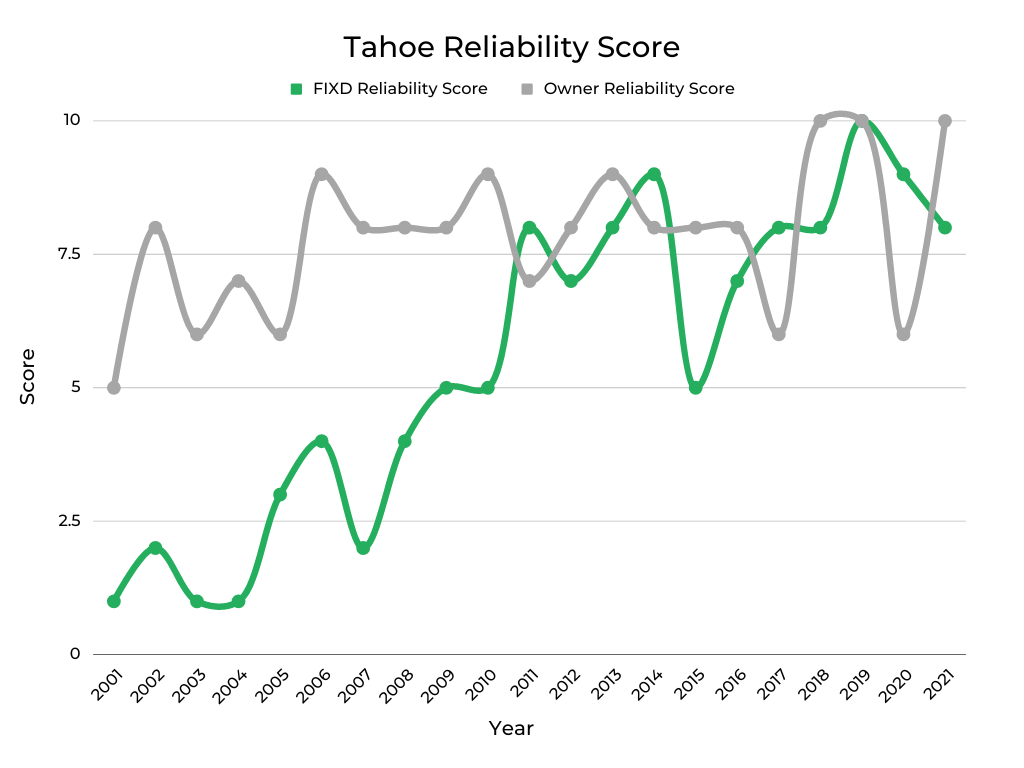
You’ll notice that the FIXD Reliability Score (engine reliability) and the Owner Reliability Score follow a common upward trend with a few exceptions. While the two indicators don’t follow the exact same path, the similarities serve as excellent checks and balances.
The FIXD Reliability Score is based on the frequency of check engine lights that happen with Chevrolet Tahoes installed with the FIXD sensor.
The Owner Reliability Score comes from survey responses that reflect perceived reliability. In simple terms, we asked Tahoe owners how suitable their vehicles are for trips of different lengths. For example, a car capable of mostly point A to point B travel ranks the lowest, while a Tahoe that can handle extended trips (including long-distance drives) scores higher. Both scales reflect 10 as the highest and 1 being the lowest (5 is average).
Check out the Chevrolet Check Engine Light article to review the most likely reasons for a check engine light to come on in a Chevrolet Tahoe and other Chevy models.
Seeing low FIXD Reliability scores for the oldest Tahoe model years isn’t unexpected. These SUVs are two decades old and have an average of 193,000 miles according to the owner survey. In other words, these are well-used vehicles.
Yes, owners of these older Tahoes felt their vehicles could handle longer trips. This isn’t necessarily a statement about engine reliability but just an acceptance that older cars have more check engine lights.
NHTSA Safety Score – Over The Years
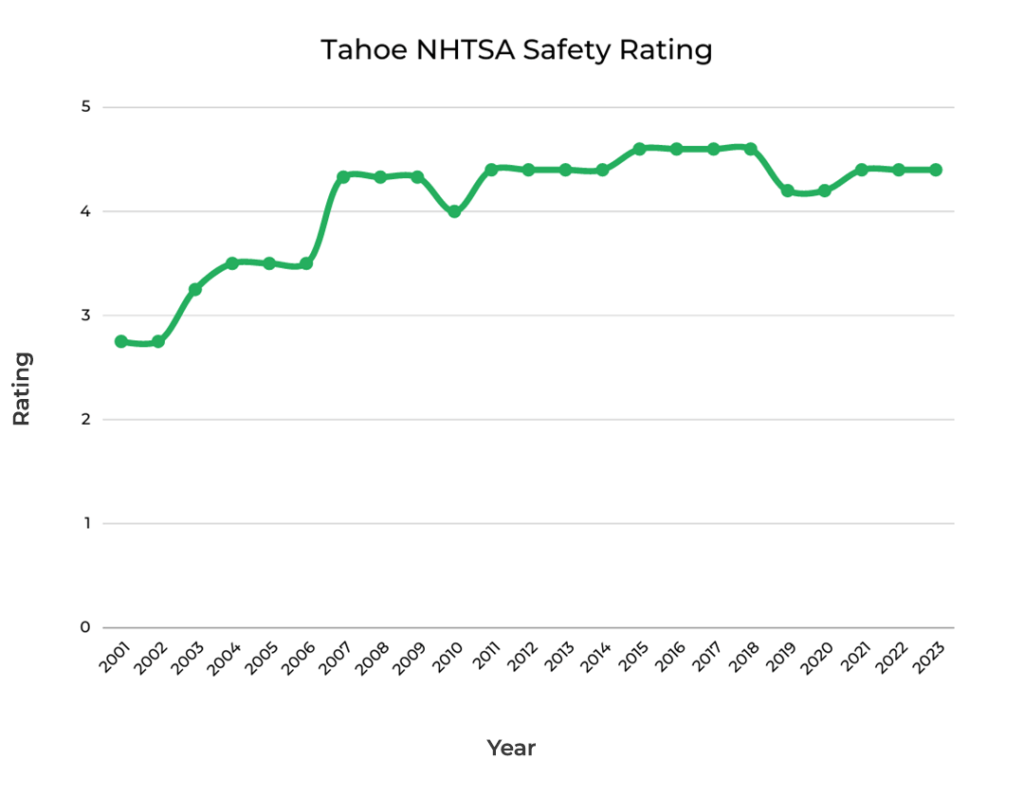
You might think a big, hulking SUV easily aces government crash tests, but the data proves otherwise for older Chevy Tahoes (2001-2006). In particular, the 2.8 (out of 5.0) ranking for the 2001 and 2002 Tahoes in crash testing from the National Highway Transportation Safety Administration (NHTSA) is about as bad as it gets. Things got slightly better for 2003 with a 3.3 score. For 2004-2006, the Tahoe notches up to 3.5.
In comparison, the 2002 Ford Expedition scored a 3.5 in the same testing, while a 2006 Nissan Armada ranked at 3.8. So, the early Tahoes are behind the competition when it comes to NHTSA crash tests.
Safety is especially important for prospective large SUV owners. For instance, the 2 most common uses for Tahoes (according to owners) are lots of driving, and use as a family vehicle, likely making safety scores very impactful in the buying decision.
Good safety scores are not only a key contributor in keeping your family safe, but they also help keep insurance costs low.
If you live in one of the states listed below, we can show you the cheapest vehicles to insure in yours.
What Used Cars Are the Cheapest To Insure In:
| What Used Cars Are the Cheapest To Insure In: |
| Ohio |
| North Carolina |
| Michigan |
| Georgia |
| Texas |
| New York |
| Illinois |
| Pennsylvania |
| California |
MPG – Over The Years
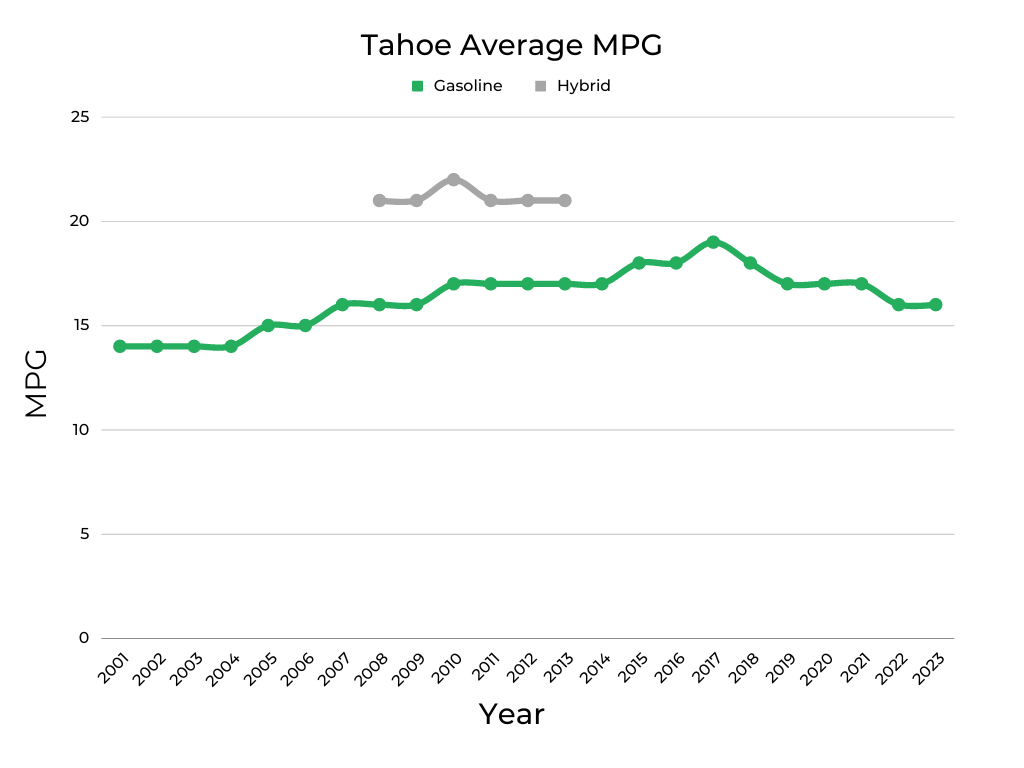
No one ever bought a Chevrolet Tahoe to save gas; there’s a penalty at the pump for a V8 engine and all that interior space. You’ll notice that Chevy offered a hybrid version of the Tahoe from 2008 to 2013, but this was more of a marketing effort when gas-guzzling SUVs weren’t in favor. The automaker got to promote 20 MPG or better, but few people bought them. In its last year, only 500 Tahoe hybrids got sold, compared to a total Tahoe production run of about 70,000 units.
Along the way, the Tahoe’s fuel economy (with regular gas engines) inched up to 18 MPG with the launch of the fourth generation in 2015. And while no one would call the newer Tahoes fuel-sippers, these Chevys are competitive in the MPG department.
Here’s how the Tahoe stacks against the Ford Expedition and Toyota Sequoia. Take note that the Ford Expedition lost its V8 engine in favor of a twin-turbo V6 beginning with the 2015 model year.
| Chevrolet Tahoe | Ford Expedition | Toyota Sequoia | |
| 2006 | 15 MPG | 14 MPG | 15 MPG |
| 2015 | 18 MPG | 17 MPG | 15 MPG |
| 2021 | 17 MPG | 19 MPG | 15 MPG |
Current Market Value of All Chevrolet Tahoe Years & Cost Per Year to Repair and Maintain Each
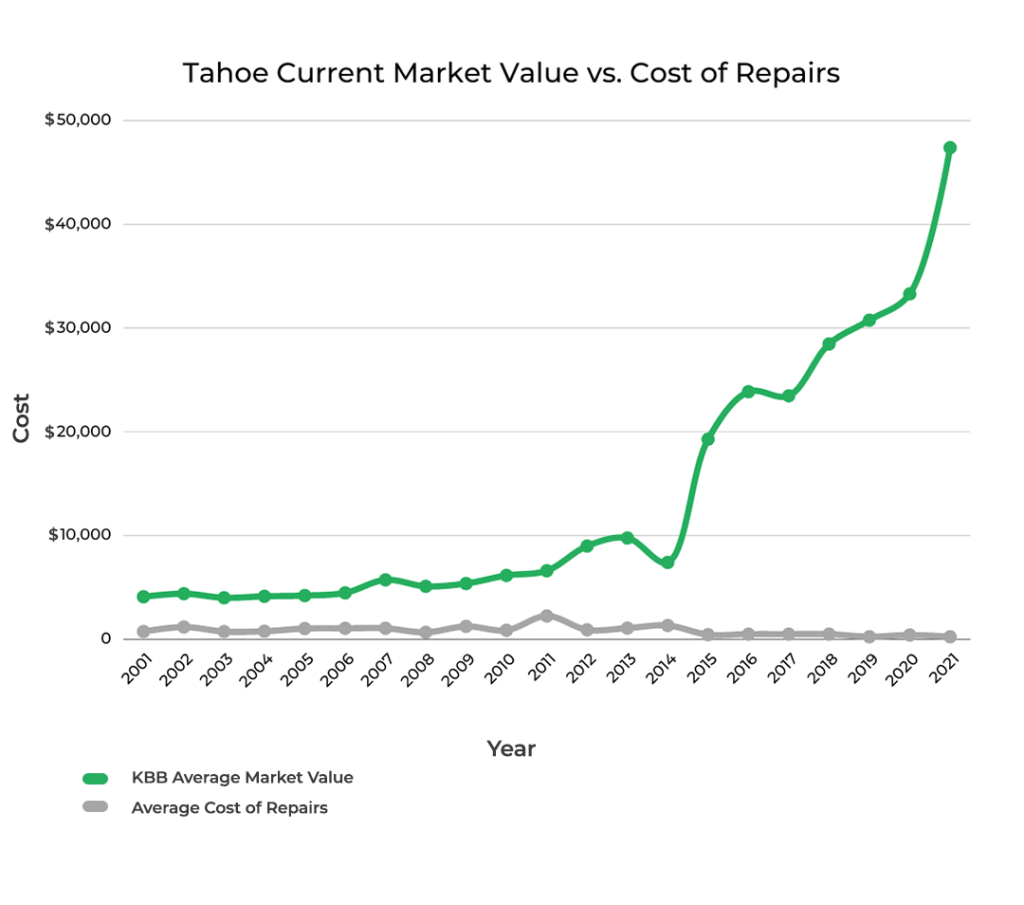
On average, a Chevy Tahoe (from 2001-2021) costs $852 per year for repairs and maintenance. However, owners report a few above-average exceptions.
A further breakdown of these expenses shows that owning a second-generation Tahoe (2001-2006) means an average annual outlay of $929 for upkeep, while a third-gen Tahoe (2007-2014) costs $1,181. And a few particularly expensive-to-maintain model years are worth paying attention to: 2009 ($1,250), 2011 ($2,250), and 2014 ($1,333).
Let’s put this in plain words. When it comes to yearly upkeep, owning an older Tahoe isn’t cheap. Consumable parts, like brake pads and tires, wear out. And even things like catalytic converters eventually need to be replaced.
And while the Chevy Tahoe can be pricey to maintain, this characteristic doesn’t harm resale value, according to KBB. Sometimes, high annual expenses can be tied to a dip in market value, but that’s not the case with the Chevrolet Tahoe.
There’s a curious drop in the value of the 2014 model. This isn’t connected to maintenance and repair expenses. Rather, this is likely due to the differences in average reported mileage. While the surveyed 2013 and 2014 Tahoe models came in with 160,000 miles and 158,000 miles, respectively, the 2015 Tahoe has an average of 75,000 miles. That’s less than half of the previous model year.
If you’d like to learn about this vehicle’s past depreciation rate & our projected depreciation rate based on that, check out: Chevrolet Tahoe | Depreciation Rate & Curve Graphed.
When shopping for a used Chevrolet Tahoe, it’s important to keep in mind that not all vehicles are cared for equally. To protect yourself from lemons, take along a FIXD Sensor on your test drive. FIXD connects to a free app on your smartphone to tell you more about the vehicle you’re checking out, including check engine lights and other hidden issues that the owner or dealership may be attempting to hide. Click here to learn more and get FIXD for only $19.99 (regular price $59)!
Important Features Timeline

1996: More powerful V8 with 50 extra horsepower, DRLs are standard
1997: A front passenger airbag is added
1998: A new automatic 4WD system and improved airbags are introduced
1999: Final year of the 1st-generation Tahoe
2000: First year of the 2nd-generation Tahoe
2001: No major updates, OnStar becomes available
2002: Upgraded suspension is standard. LS trim gets power front seats
2003: Many updates, including tri-zone HVAC and optional 2nd-row captain’s chairs
2004: Improved brakes are standard
2005: Touchscreen navigation is optional
2006: Traction control and tire monitoring are standard
2007: All-new 3rd-generation Tahoe debuts
2008: The Tahoe Hybrid is introduced
2009: A 3rd-row seat is standard, new 395 HP V8 is optional
2010: The 5.3-liter V8 becomes the only engine (other than hybrid power)
2011: The base LS trim gets Bluetooth and some other extras
2012: A heated steering wheel and heated/cooled front seats get added to the LTZ
2013: No major changes as the third-generation winds down
2014: Final year of the third generation, the base LS gets remote start and other upgrades
2015: The 4th-generation Tahoe debuts sharing Silverado pickup’s platform
2016: Base LS gets safety upgrades such as forward-collision warning
2017: The Premier takes over for the LTZ as the top Tahoe trim
2018: The RST special edition offers 420HP and other performance enhancements
2019: No changes for the Chevrolet Tahoe
2020: Last year of the 4th generation
2021: The redesigned 5th-generation Tahoe launches
Best Years of the Chevrolet Tahoe

Our selections for the most-reliable Chevrolet Tahoe model years are based on FIXD Reliability Scores, Owner Reliability Scores, government crash test results, and fuel economy rankings. In addition, these picks are also influenced by common diagnostic trouble code (DTC) codes, and NHTSA recall information.
2016-2020 Chevrolet Tahoe
FIXD Reliability Score: 7-10/10
Owner Reliability Score: 6-10/10
KBB Value: $23,871-$33,292
Fuel Economy: 17-19 MPG
Average Annual Maintenance/Repair: $250-$500
Average Likelihood of a $500+ Repair in 2022: 100%
Safety Rating: 4.2-4.6/5
What’s not to like about a newer Tahoe other than the price tag? High reliability scores (from both the FIXD app and owners) and low maintenance costs have strong appeal. In particular, 2019 is the year to shoot for, as this Tahoe gets a 10 for engine and owner reliability. You can expect to pay about $35,000 to $40,000 or more for one with low mileage.
Generally, many of the available Tahoes in this group may still have the original bumper-to-bumper warranty (3 years/36,000 miles) or powertrain coverage (5 years/60,000 miles). And you’re likely to find many examples available through Chevrolet’s certified pre-owned (CPO) program. You’ll pay a premium for this upgrade but receive an extra six months or 6,000 miles of bumper-to-bumper coverage to any existing factory warranty.
The certainty (100%) of expensive repairs ($500+) is mainly due to maintenance issues like tires and brake pads. The average Tahoe in this grouping had 78,000 miles, translating into upkeep requirements beyond basic oil changes.
Owners of these Tahoes can take confidence in that there’s a 0% chance of repairs related to the engine or transmission.
However, this is a good time to mention that no vehicle is flawless. At some point, every car needs repairs. With this in mind, we dug into the data for likely DTC codes for these Tahoe model years. P0128 is the most frequent code for the 2016 Tahoe, indicating a problem with the engine coolant thermostat. While diagnosing the situation is relatively inexpensive ($75-$150), replacing the thermostat can run $500 to $700. In extreme cases, repairs can cost $2,049 to $2,567 if the remedy involves replacing the powertrain control module (PCM). The PCM monitors the thermostat.
DTC code P0420, a bad catalytic converter, is another error message that may arise with the 2016 Tahoe. Ordinarily, these problems don’t occur in newer vehicles, but contributing factors like cheap gas and contaminants could be to blame. If the matter doesn’t fall under Chevy’s 8-year or 80,000-mile emissions warranty, expect to pay $1,720 to $2,400 to replace the catalytic converter.
Other potentially troubling codes arise with the 2020 Tahoe. These DTCs involve the automatic transmission, and specifically the transmission control module (P0700) and the torque converter lockup solenoid (P0741). If the warranty isn’t applicable, repairs can cost $2,528 to $3,045.
Owners among this grouping of Tahoes reported numerous likes and dislikes. The favorite feature? Great driver visibility (20%). What met the most amount of disfavor is the lack of storage (67%). We take this to be about stowing personal items (cell phones, sunglasses, etc.) in the front row, as the Tahoe is not lacking cargo storage.
Most owners (48%) report using their Tahoes for traveling and commuting, while 29% engage this SUV for family hauling. Lesser numbers get behind the wheel for “fast driving,” “luxurious driving,” or as an office on wheels.
While the 2019-2020 Tahoe crash test scores dip to 4.2 (out of 5.0), the 2016-2018 model years deliver an impressive 4.6 ranking. Overall, driving confidence and the 2016-2020 Tahoe go hand in hand. Recalls are a fact of life with modern automobiles, and the Tahoe is no exception. The 2016 and 2017 model years have 9 and 6 recalls, respectively, but the 2018 through 2020 Tahoes only have three per year, the lowest of any 21st-century Tahoe.
If the budget allows, the 2016-2020 Tahoes are the ones to buy. They offer an ideal combination of depreciation and modernity.
2011, 2013 Chevrolet Tahoe
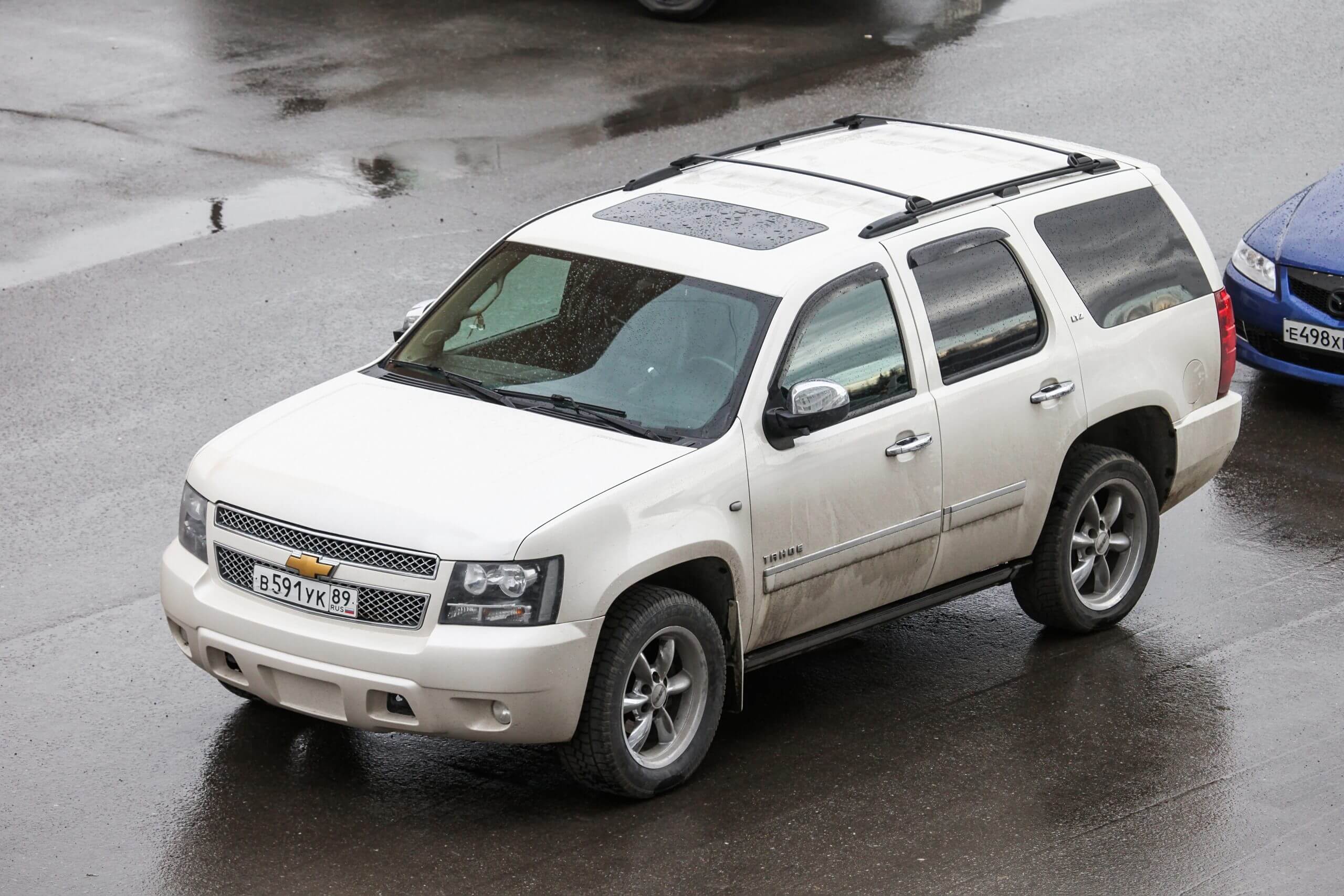
FIXD Reliability Score: 7-8/10
Owner Reliability Score: 8-9/10
KBB Value: $6,606-$9,766
Fuel Economy: 17 MPG
Average Annual Maintenance/Repair: $1,083-$2,250
Average Likelihood of a $500+ Repair in 2022: 86%-100%
Safety Rating: 4.4/5
You’ll notice the 2012 Tahoe is missing from this group. That one made our worst list, which you can read about later. That said, the 2011 and 2013 Tahoes are the model years of choice if you’ve only got $10,000 to $15,000 to plunk down on a full-size Chevy SUV.
These Tahoes have impressively high FIXD Reliability and Owner Reliability Scores, with owners giving the 2013 Tahoe a near-perfect 9 out of 10. That’s quite an accomplishment for a decade-old vehicle.
Yes, annual maintenance and repair costs are eye-opening, with the 2011 model year requiring $2,250. But, as we mentioned, paying for an older Tahoe’s upkeep isn’t a bargain. Based on the owner surveys, we also like that the 2011 Tahoe has zero chance of needing expensive engine repairs (another noteworthy feat for an older SUV). In comparison, the 2013 has a 14.3% likelihood of needing this type of work. You’ll need to pick between higher yearly maintenance outlays (2011) or an elevated chance of engine issues (2013).
DTC P0300 isn’t uncommon with these Tahoe model years. The code signals an engine misfire which can be serious. Meanwhile, the remedy can be as simple as new spark plugs (cost: $58-$167) or as pricey as a new catalytic converter.
Similarly, DTC P0302 and P0305 can also occur. Both also involve engine misfires. Besides new spark plugs, the fix could involve something minor like a vacuum leak (cost: $100-$200) or a significant problem affecting the fuel injectors (cost: $1,500-$1,900) or the fuel pump (cost: $1,300-$1,700).
The owner survey uncovers that these Tahoes have an average of 175,000 miles on the clock. Slightly more owners (29%) are doubtful their Tahoes will crack the 200,000-mile mark, while 22% are confident they’ll make it that far. Like other respondents, most owners of 2011 and 2013 Tahoes use their SUVs for travel, commutes, and family transportation.
While not the highest-performing Tahoes in NHTSA safety testing, the 2011 and 2013 model years achieved a 4.4, which is noteworthy for vehicles of this age. Yet, an average fuel economy rating of 17 MPG is nothing to write home about, but this is a Tahoe, after all.
2006 Chevrolet Tahoe
FIXD Reliability Score: 4/10
Owner Reliability Score: 9/10
KBB Value: $4,475
Fuel Economy: 15 MPG
Average Annual Maintenance/Repair: $1,063
Average Likelihood of a $500+ Repair in 2022: 50%
Safety Rating: 3.5/5
We’re giving a reluctant thumbs up to the 2006 Chevrolet Tahoe for one primary reason, it’s the only one to buy if you’ve got less than $10,000 to spend. The older examples are even worse (details below), so we’ll dub the 2006 Tahoe the “least-best” one to buy.
Ordinarily, a FIXD Reliability Score of 4 would push a vehicle into the do-not-buy category, but seeing a 9 from the Owner Reliability Score is encouraging. And compared to some newer examples, average annual maintenance and repair expenses of $1,063 aren’t too bad.
Of course, there’s a 50% chance of an expensive repair, which could involve more than tires or brake pads. Notably, there are even odds (50%) that the work will center on the engine. Surprisingly, the transmission doesn’t appear to be a likely issue, which is one of the saving graces for this Tahoe model year.
Common DTC codes that can show up with the 2006 Tahoe can include P0135, which indicates a faulty oxygen sensor. Repairs at $200-$300 won’t set you back too much. But other codes, P0153 (bad heated oxygen sensor) and P0300 (engine misfire, detailed earlier), can be more expensive. In particular, repairing P0153 could involve correcting a vacuum leak (cost: $100-$200) or replacing a bad mass airflow (MAF) sensor (cost: $220-$320). But, more extensive work requiring a new catalytic converter or powertrain control module (PCM) wouldn’t be a surprise.
The average 2006 Tahoe in our survey has 212,000 miles. However, despite this usage, 17% of owners reported confidence in their vehicle reaching the 200,000-mile threshold (or already made it).
We’ll just whistle as we casually walk past the 15 MPG rating for this Tahoe. Yes, fill-ups will be expensive. And a 3.5 crash test score isn’t inspiring, but changing to a newer Tahoe with better results will require a budget increase of one-third to one-half. “It is what it is” is the best way to describe the 2006 Tahoe.
The Worst Years of the Chevrolet Tahoe
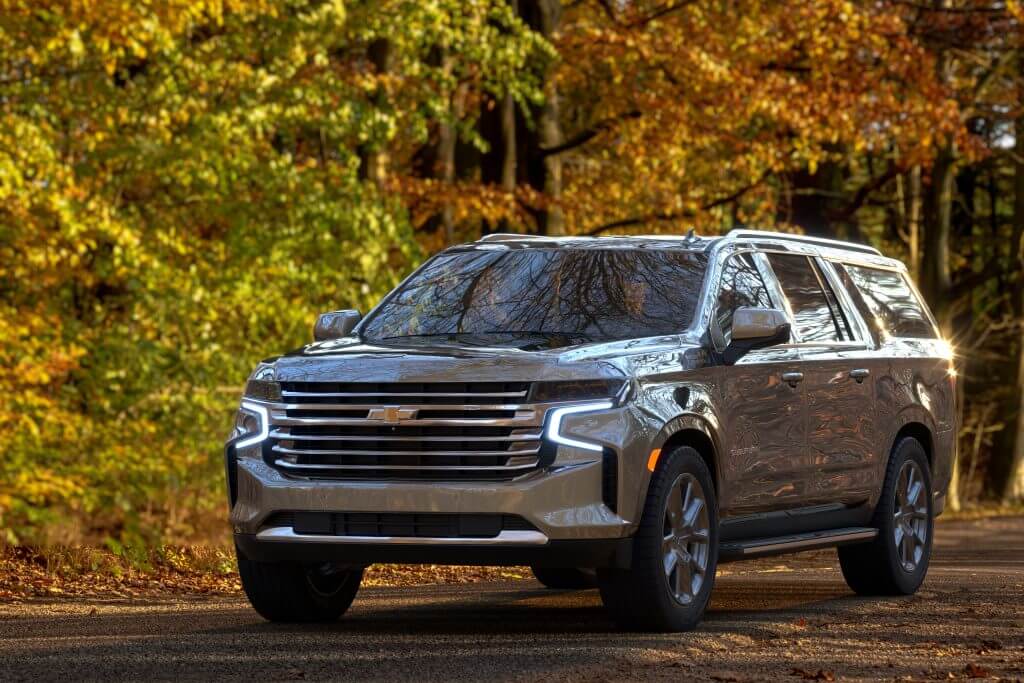
Unfortunately, there are more bad years for the Chevrolet Tahoe than good ones. These findings (based on FIXD Reliability Score, Owner Reliability Score, and other vital factors) highlight what Tahoes to avoid if you’re SUV shopping. At the same time, these details can be insightful if you own a Tahoe on this side of the list.
2021 Chevrolet Tahoe
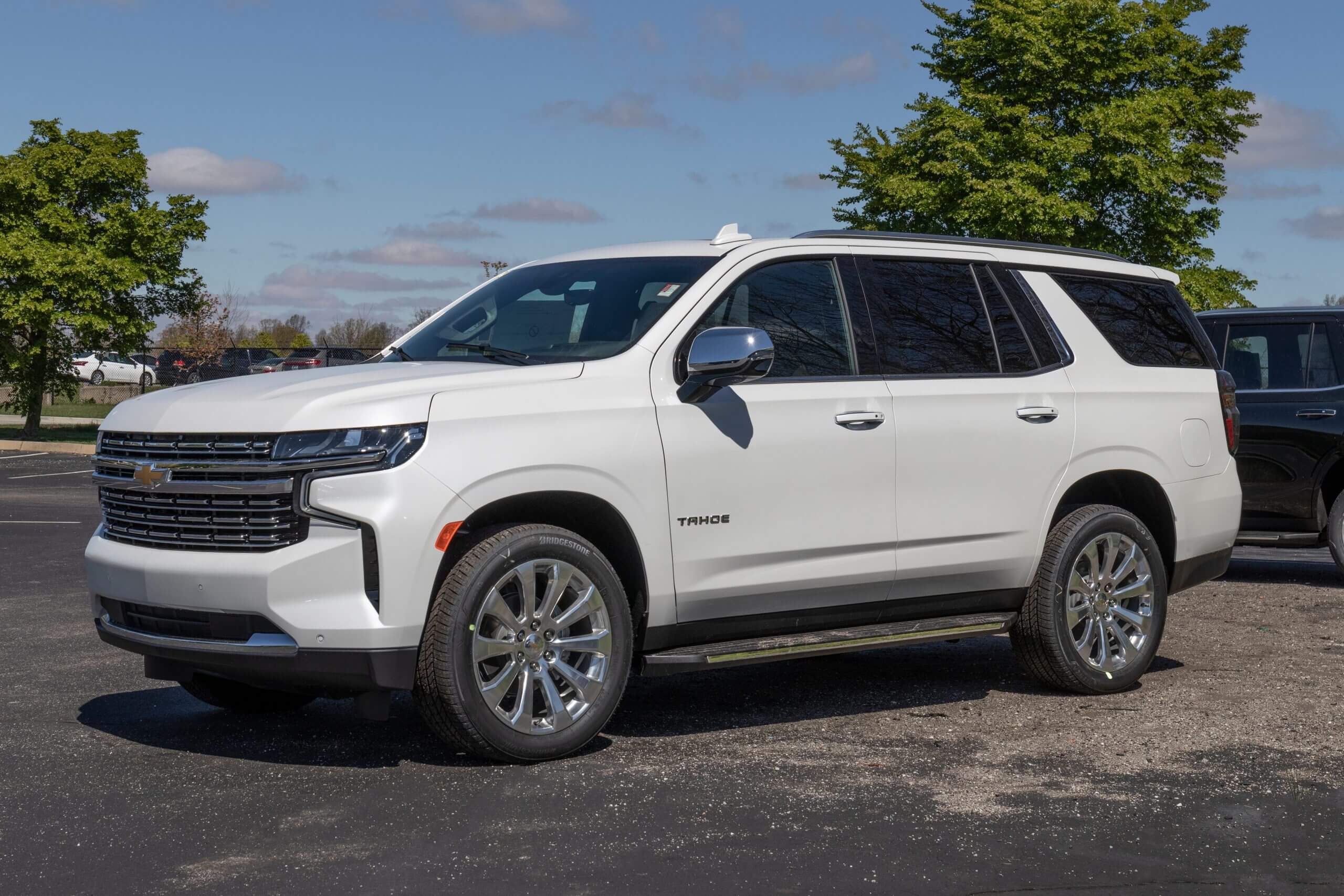
FIXD Reliability Score: 8/10
Owner Reliability Score: 10/10
KBB Value: $47,384
Fuel Economy: 17 MPG
Average Annual Maintenance/Repair: $250
Average Likelihood of a $500+ Repair in 2022: 80%
Safety Rating: 4.⅘
You may be perplexed by seeing an almost-new Tahoe on a do-not-buy list, but we subscribe to the philosophy of never purchasing an all-new vehicle during its first year (and sometimes the second year) of a generation. Automakers have a knack for saying “good enough” when launching a new car and letting the service departments and owners sort through the resulting problems.
Could the 2021 Tahoe prove to be the best one ever built? Sure, but for now, there’s too little data to prove one way or another. So, we recommend exercising caution before dropping 50 large or more on a used SUV.
Some other red flags also cause us to give a thumbs down to this Tahoe. To start with, 13 recalls shouldn’t be taken lightly. Yes, these issues can all get fixed for free. But the sheer number of these problems is a cautionary tale. It’s possible that other problems exist but they just aren’t classified as recalls yet.
In addition, a FIXD Reliability Score of 8 is not all too great for a practically new vehicle.
Let’s get into the specifics of this.
FIXD app data reveals P0562 as a frequent error code for the 2021 Tahoe. That’s an indicator of low voltage. While the problem can frequently be traced to a bad car battery (cost: $310-$340), the issue also can be associated with a troublesome electrical system. Unless covered by a warranty, a new alternator costs $570 to $750, and replacing the wiring can run up to $1,000. Sometimes, a new PCM can also be involved.
Need more reasons to stay away from the 2021 Tahoe? Other expensive repairs could be in the future, with a 20% likelihood of engine work and a 16.7% probability of transmission issues being the culprit. That shouldn’t be something to worry about in a newer vehicle.
Granted, the 2021 doesn’t have as much data on it as some others in our list but, just to be safe, avoid the first year, the data we do have isn’t looking great.
We’ll also mention that there’s very little data on the 2022 and 2023 Tahoe, which is why these model years haven’t even made our charts.
2015 Chevrolet Tahoe
FIXD Reliability Score: 5/10
Owner Reliability Score: 8/10
KBB Value: $19,290
Fuel Economy: 18 MPG
Average Annual Maintenance/Repair: $450
Average Likelihood of a $500+ Repair in 2022: 100%
Safety Rating: 4.6/5
As the debut edition of the fourth-generation Tahoe, the 2015 version is another example of a Chevy SUV to avoid. Think of this, for a few bucks more, you could step up to a 2016 Tahoe and avoid a FIXD Reliability Score of 5 (the 2016 model year received a 7).
There’s also another warning sign, 16 recalls. That’s more than any other Tahoe model year. Keep in mind that recalls are what Chevrolet admits to. There can be countless more issues lurking for unsuspecting owners. Many cars undergo a recall, but dealing with a double-digit amount of problems is something to bring pause.
A review of frequent DTC codes reveals the usual suspects (covered earlier) of P0128 (engine coolant thermostat) and P0300 (engine misfires). But, P0430 (catalytic converter) can also surface and require an expensive repair (a new catalytic converter).
Also troubling is a 12.5% chance of the 2015 Tahoe needing expensive transmission work. That may not seem significant, but this type of problem shouldn’t appear in a vehicle less than ten years old and with an average of 75,000 miles.
Is there anything to redeem the 2015 Tahoe? Sure, a low annual upkeep (for now) of $450 and a praise-worthy 4.6 in government crash tests are notable. Even an average fuel economy rating of 18 MPG is remarkable (for a large, lumbering SUV). But, none of these advantages outweigh the potential for misery in the reliability department.
2007-2010, 2012, and 2014 Chevrolet Tahoe
FIXD Reliability Score: 2-9/10
Owner Reliability Score: 7-9/10
KBB Value: $5,729-$7,409
Fuel Economy: 16-17 MPG
Average Annual Maintenance/Repair: $675-$1,333
Average Likelihood of a $500+ Repair in 2022: 33%-88%
Safety Rating: 4.0-4.⅘
We covered good examples (2011 and 2013) of the third-generation Chevrolet Tahoe. So, now, let’s get to the bad ones. And while these model years enjoy solid Owner Reliability Scores, other factors make these Tahoes undesirable choices.
The 2007 and 2008 Tahoes have quite poor FIXD Reliabilities Scores of 2. That’s almost as bad as it gets. The 2009 and 2010 model years improve to a score of 5, but this is heavily marred by a 25%-40% chance of expensive engine repairs. Many would find a one-in-four (or worse) likelihood of a troublesome engine not ideal.
Meanwhile, the 2012 and 2014 versions rise in the FIXD Reliability Score with a 7 and a 9, respectively. However, the possibility of pricey engine problems increases to 66.7% for the 2012 Tahoe and 50% for the 2014 edition. Those are scary odds.
As covered in some of the previous Tahoe groupings, DTC codes P0300, P0302, and P0305 are also familiar territory here. As you may recall, these codes deal with engine misfires. And problems can range from a bad spark plug to a malfunctioning catalytic converter.
Other codes to worry about include P0121 (a faulty throttle body actuator) and P0171 (a malfunctioning mass airflow sensor). Dealing with a throttle body actuator could involve correcting damaged wiring, replacing a bad sensor (cost: $130-$230), or swapping out the actuator itself (cost: $500-$700). Meanwhile, fixing the mass airflow (MAF) sensor often involves a cleaning (cost: $20-$100). However, these repairs can be more expensive, requiring a vacuum leak fix or replacement of the MAF sensor (cost: $230-$330).
Lastly, owners of these Tahoe model years can encounter P0521, a troublesome oil pressure sensor (a severe issue requiring the car to be turned off immediately). The first steps to correcting this problem may involve topping off low oil and or replacing the dirty oil and oil filter. The matter could escalate to replacing the sensor (cost: $123 to $140) or replacing a leaking oil pan (cost: $654-$740).
Because other options are available, we suggest passing on the 2007-2010, 2012, and 2014 Chevrolet Tahoe.
2001-2005 Chevrolet Tahoe
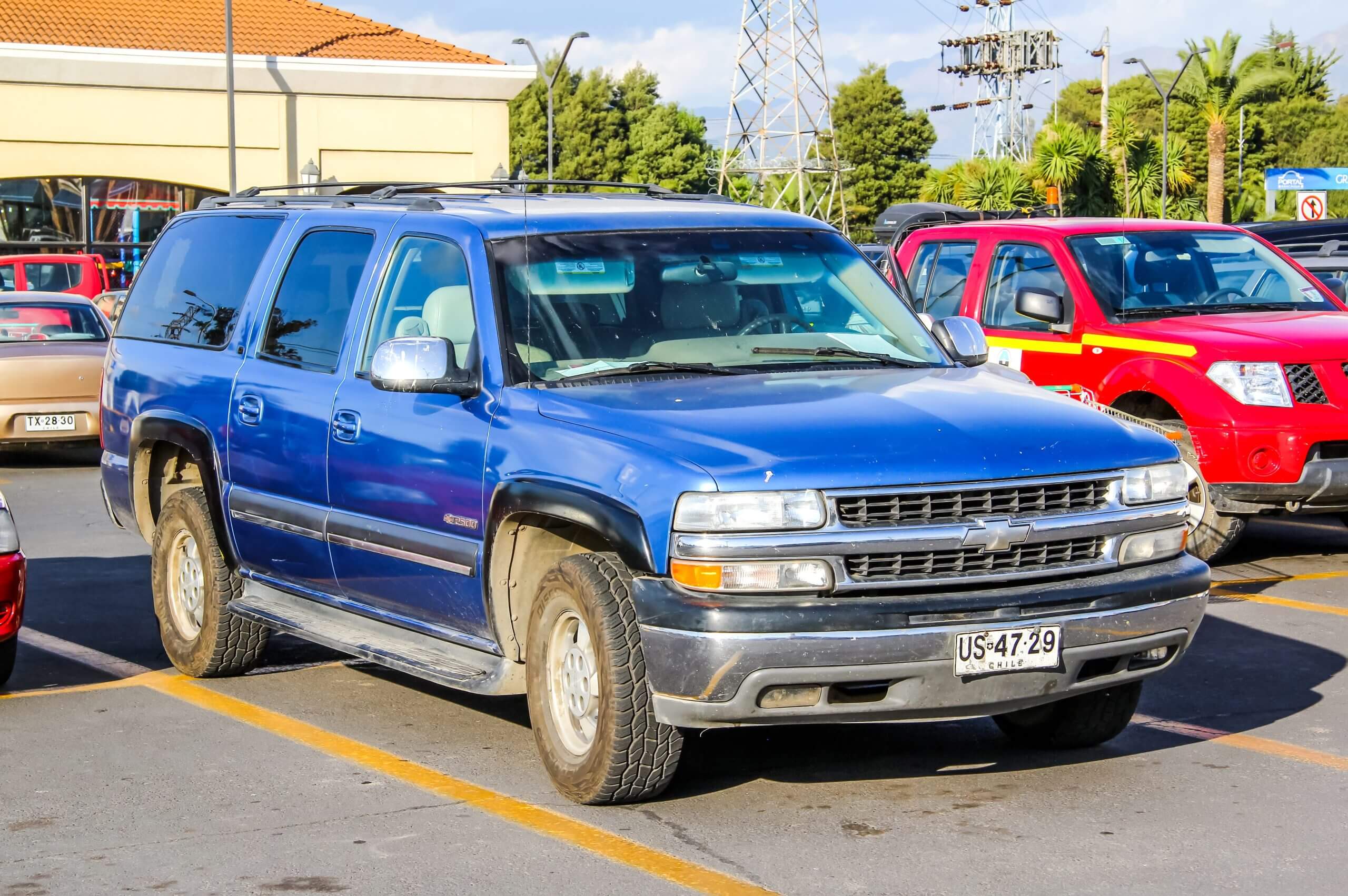
FIXD Reliability Score: 1-3/10
Owner Reliability Score: 5-8/10
KBB Value: $4,101-$4,399
Fuel Economy: 14-15 MPG
Average Annual Maintenance/Repair: $750-$1,188
Average Likelihood of a $500+ Repair in 2022: 67%-86%
Safety Rating: 2.8-3.5/5
If there’s one group of Tahoe model years to run away from, it’s those from 2001-2005. And while low prices may be tempting, you’ll pay for it in the long run. Why?
Let’s start with absolutely terrible FIXD Reliability scores. In particular, 2001, 2003, and 2004 sit at the bottom of the barrel with a pitiful 1 out of 10. Meanwhile, the 2002 Tahoe gets a 2, and the 2005 model year is the “high achiever” with a 3.
Admittedly, the Owner Reliability Score is better with a range of 5-7, but perhaps owners of 20-year-old vehicles are more accepting of a finicky car than a new car payment. They also don’t see the data showing a high likelihood (78%, on average) of expensive repairs. There’s a 30% or better chance for the 2004 and 2005 Tahoe to need engine work costing $500 or more. Owners of the 2002 Tahoe have a one-in-three possibility for pricey transmission repairs that could approach the value of the entire vehicle.
We’ll add insult to injury by pointing out that the 2001 and 2002 Tahoes scored a lowly 2.8 (out of 5) in government safety tests. At least the 2003 edition notched up to 3.3, while the 2004 and 2005 Tahoes achieved a mediocre 3.5. Unsurprisingly, with an average fuel economy rating of 13 MPG or 14 MPG, this era of Tahoe models is the most costly to fill up than any other model year in our review.
Finally, if the data isn’t convincing enough to avoid the 2001-2005 Tahoe model years, think about this. Soon enough, these vehicles will hit the 25-year mark and are classifiable as classic cars. Have you ever come across a reliable classic car?
Frequently Asked Questions: Best & Worst Years of Chevrolet Tahoe
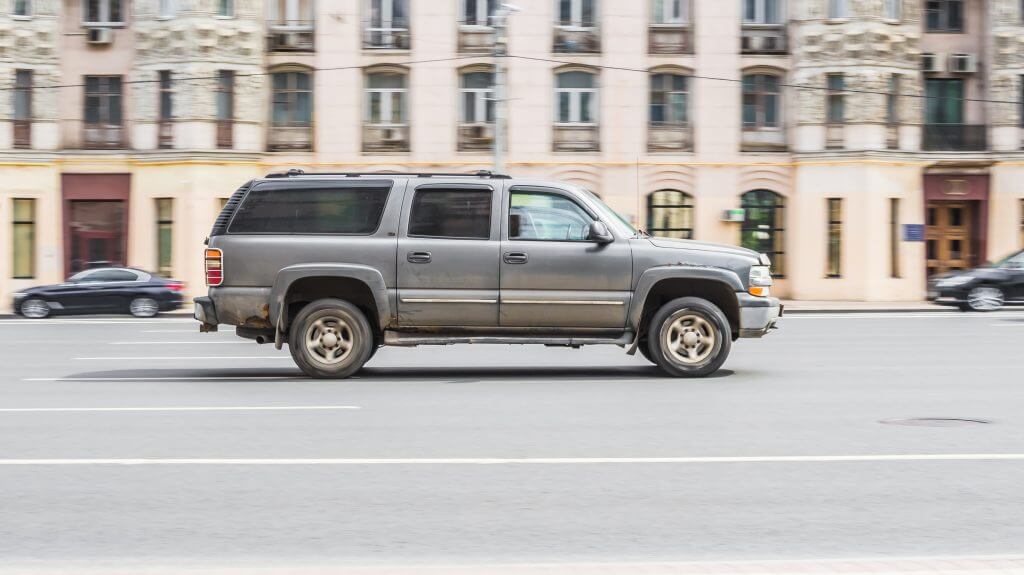
What years of the Chevrolet Tahoe have engine and/or transmission problems?
Regrettably, many Chevy Tahoe model years are notorious for engine and transmission problems. Using a one-in-five (20%) or greater probability as a benchmark for such issues, be alert to engine troubles with Tahoes from 2004-2006, 2010-2012, 2014, and 2021. Using a similar threshold, the 2002, 2004, and 2011 Tahoes are also more vulnerable to transmission problems.
What is considered high mileage for a Chevrolet Tahoe?
A “high mileage” determination for a Chevy Tahoe really comes down to the individual vehicle. Usage and maintenance have a lot to do with this. The survey shows that some owners with 175,000 miles or more feel their Tahoes will continue to do their duty. While others with as little as 75,000 miles are doubtful their vehicles will make it that far. Interestingly, surveyed Tahoe owners offered mixed results when asked about the perceived longevity of their vehicles. 19% believe their car can make it (or already has) to 200,000 miles, while 16% feel otherwise.
Do any hybrid years have problems?
Chevy offered the Tahoe as a hybrid from 2008 to 2013, but sales were modest. As a result, there is no specific data on how the hybrid engine held up against the conventional gas-powered V8s sold during these years. Because hybrid batteries become depleted over time, the hybrid system should be thoroughly inspected if considering a Tahoe hybrid.
What other vehicles should I consider?
Chevrolet offers an extensive array of SUVs and crossovers in addition to the Tahoe. If more space is needed, the Suburban has an unmatched amount of interior room (it’s a stretched version of the Tahoe. The Traverse provides three rows of convenience for a smaller but still capable people mover. From there, Chevy sells crossovers ranging from the compact Blazer and Equinox to the subcompact Trailblazer and Trax.
Going outside the General Motors family, direct non-luxury competitors to the Tahoe include the Ford Expedition, Toyota Sequoia, and Nissan Armada.
What owners of the Chevrolet Tahoe like to use their cars for:
| Frequent Use Categories: | How Useful? (Out of 5 Stars) |
| Lots of Driving (travel/long commute) | **** |
| Family Vehicle | *** |
| Sport/Fast Driving | ** |
| Hauling/Towing | * |
| Office on Wheels | * |
| Luxurious Driving | * |
| Outdoor/Off-Road | * |
References
- Chevrolet Tahoe model-specific information, edmunds.com (various dates). Retrieved April 14, 2023, from https://www.edmunds.com/
- Model-specific recall information as per the National Highway Transportation Safety Administration. Retrieved April 14, 2023, from https://www.nhtsa.gov/recalls
- Chevrolet Limited Warranty document (2017). Retrieved April 6, 2023, from https://tinyurl.com/5n6m7kp4
A Note About Data and Information Sources
This article has many details about Chevrolet Tahoe reliability; here’s what we used for our assumptions and recommendations.
- FIXD Reliability Score & Data: Engine reliability information is captured via the FIXD App.
The FIXD Reliability Score is calculated using the number of DTCs per year, weighted by mileage. This is then turned into a scale of 1-10 for easy graphing.
This is an objective score.
- Owner Reliability Score & Data: This data is the result of surveying Chevrolet Tahoe owners who use FIXD.
The Owner Reliability Score comes straight from owners of the Chevrolet Tahoe.
This is a subjective score.
To determine the Owner Reliability Score we ask each car owner:
How reliable would you say your Chevrolet Tahoe is?
a. Just point A to point B driving
b. A Daily Commuter
c. Good for a 100 mile road trip
d. Good for a 500 mile road trip
e. I could take a cross-country road trip, no problem
From here we translate their answers into the Owner Reliability Score:
a. = 2
b. = 4
c. = 6
d. = 8
e. = 10
Keep in mind, owners may think their car is more or less reliable than it actually is.
One potential problem is that people often buy the same make or model they are used to when they go car shopping, just a newer year.
Ford, for instance, has a number of consumer loyalty awards for the Ford F-Series, Ford Mustang, and Ford Expedition.
Car owners may be so loyal to the make or model they currently own that they would have trouble accurately comparing their cars’ reliability to others.
It’s for this reason that the Owner Reliability Score. We intentionally ask car owners a question that is relative to mileage rather than relative to other cars.
Still, be mindful of the accuracy of these Owner Reliability Scores, people’s perceptions and unconscious blindspots can skew data.
We suggest looking at both the FIXD Reliability Score and the Owner Reliability Score for this reason.
- KBB Value: Average private-seller valuations as supplied by Kelley Blue Book (KBB), based on a {make} {model} with typical mileage for that respective model year.
- Fuel Economy: Mileage-per-gallon estimates according to the EPA MPG on Fueleconomy.gov
- Annual Maintenance/Repair: Upkeep expenses as reported by surveyed Chevrolet Tahoe owners
- Safety Rating: Crash test data collected and reported by NHTSA. We average all ratings for each year to come up with a simplified, average safety score. This makes it easier to look at on a graph.

Dave Goldberg is an automotive journalist and lifelong car fanatic. He writes for numerous enthusiast and business outlets and is an ongoing contributor to HotCars.com, one of the most popular car culture websites. When he’s not writing or driving, Dave is either under a hood or asleep. His credentials include a BA in Journalism from The George Washington University.

